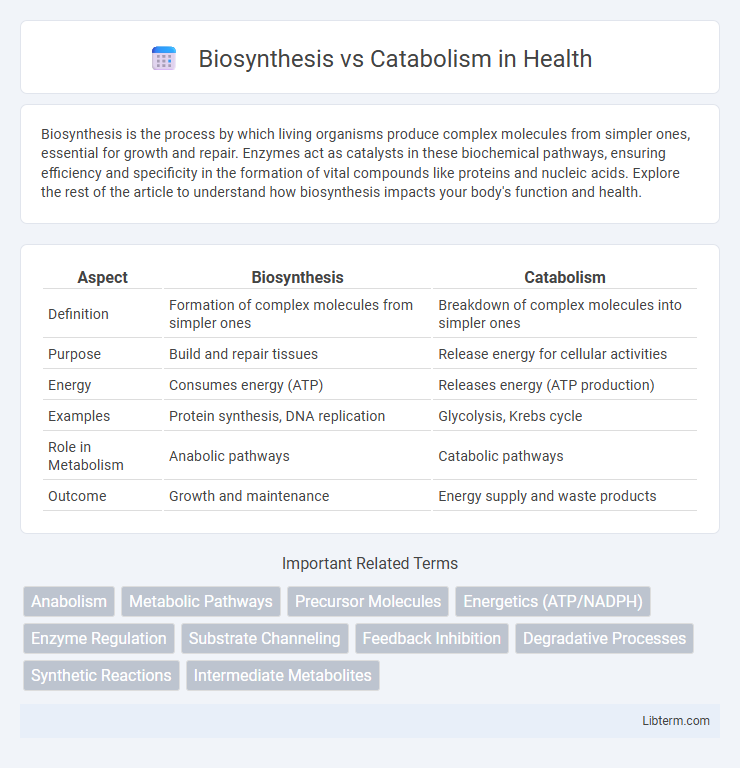Biosynthesis is the process by which living organisms produce complex molecules from simpler ones, essential for growth and repair. Enzymes act as catalysts in these biochemical pathways, ensuring efficiency and specificity in the formation of vital compounds like proteins and nucleic acids. Explore the rest of the article to understand how biosynthesis impacts your body's function and health.
Table of Comparison
| Aspect | Biosynthesis | Catabolism |
|---|---|---|
| Definition | Formation of complex molecules from simpler ones | Breakdown of complex molecules into simpler ones |
| Purpose | Build and repair tissues | Release energy for cellular activities |
| Energy | Consumes energy (ATP) | Releases energy (ATP production) |
| Examples | Protein synthesis, DNA replication | Glycolysis, Krebs cycle |
| Role in Metabolism | Anabolic pathways | Catabolic pathways |
| Outcome | Growth and maintenance | Energy supply and waste products |
Introduction to Biosynthesis and Catabolism
Biosynthesis and catabolism are fundamental metabolic processes essential for cellular function and energy management. Biosynthesis involves the construction of complex molecules from simpler precursors, enabling cell growth, repair, and replication by using energy and raw materials. Catabolism, in contrast, breaks down complex molecules into simpler ones, releasing energy stored in chemical bonds to power various cellular activities.
Definitions: What is Biosynthesis?
Biosynthesis is the cellular process by which living organisms produce complex molecules from simpler ones, essential for growth and repair. It involves anabolic pathways that consume energy to build macromolecules like proteins, lipids, and nucleic acids. This process contrasts with catabolism, which breaks down molecules to release energy.
Definitions: What is Catabolism?
Catabolism is the metabolic process that breaks down complex molecules into simpler ones, releasing energy stored in chemical bonds. This energy is typically captured in the form of adenosine triphosphate (ATP), which cells use to power various functions. Catabolism contrasts with biosynthesis, where smaller molecules are built up into larger, energy-consuming compounds.
Key Differences Between Biosynthesis and Catabolism
Biosynthesis involves anabolic pathways that construct complex molecules like proteins and nucleic acids from simpler ones, requiring energy input typically in the form of ATP. Catabolism encompasses metabolic pathways that break down complex molecules such as carbohydrates, lipids, and proteins into simpler compounds, releasing energy stored in chemical bonds. The key difference lies in energy flow: biosynthesis consumes energy for growth and repair, while catabolism generates energy to fuel cellular activities.
Biological Importance of Biosynthesis
Biosynthesis is crucial for cellular function as it enables the production of essential macromolecules like proteins, nucleic acids, and lipids required for growth, repair, and reproduction. It supports anabolism by converting simple molecules into complex compounds, ensuring the maintenance of cellular structures and metabolic balance. This process is vital for sustaining life, facilitating cell differentiation, and adapting to environmental changes.
Biological Role of Catabolism in Cells
Catabolism plays a crucial biological role in cells by breaking down complex molecules like carbohydrates, lipids, and proteins into simpler units, releasing energy stored in chemical bonds. This energy is primarily captured in the form of ATP, which powers various cellular functions such as muscle contraction, active transport, and biosynthesis. Moreover, catabolic pathways generate essential metabolic intermediates that serve as precursors for anabolic processes, maintaining cellular homeostasis and growth.
Energy Flow: Anabolism vs Catabolism
Anabolism drives energy flow by consuming ATP to build complex molecules from simpler ones, supporting cell growth and repair. Catabolism releases energy by breaking down macromolecules into smaller units, generating ATP through pathways like glycolysis and the Krebs cycle. The balance between anabolic and catabolic processes maintains cellular energy homeostasis essential for metabolic function.
Main Pathways in Biosynthesis
Biosynthesis primarily involves anabolic pathways such as the Calvin cycle, fatty acid synthesis, and amino acid biosynthesis, which build complex molecules from simpler precursors. These pathways require energy input, typically in the form of ATP and NADPH, to drive the formation of macromolecules essential for cell growth and function. Key enzymes like ribulose-1,5-bisphosphate carboxylase-oxygenase (RuBisCO) in the Calvin cycle and acetyl-CoA carboxylase in fatty acid synthesis regulate the rate of these biosynthetic processes.
Main Pathways in Catabolism
Catabolism primarily involves the breakdown of complex molecules through key pathways such as glycolysis, the citric acid cycle, and oxidative phosphorylation, which collectively convert glucose, fatty acids, and amino acids into usable energy in the form of ATP. Glycolysis breaks down glucose into pyruvate, producing small amounts of ATP and NADH, while the citric acid cycle further oxidizes these products to generate NADH and FADH2, essential electron carriers. Oxidative phosphorylation uses electrons from NADH and FADH2 to drive ATP synthesis via the electron transport chain in mitochondria, making it the most efficient step in energy extraction during catabolism.
Comparative Summary: Biosynthesis vs Catabolism
Biosynthesis and catabolism are fundamental metabolic processes with contrasting roles: biosynthesis involves the construction of complex molecules from simple precursors, consuming energy primarily in the form of ATP, while catabolism breaks down complex molecules into simpler ones, releasing energy stored in chemical bonds. Catabolic pathways, such as glycolysis and the citric acid cycle, generate ATP and reducing equivalents like NADH, which in turn fuel biosynthetic pathways including protein synthesis, lipid biosynthesis, and nucleic acid assembly. The balance between these processes maintains cellular homeostasis and supports growth, repair, and energy management in organisms.
Biosynthesis Infographic

 libterm.com
libterm.com